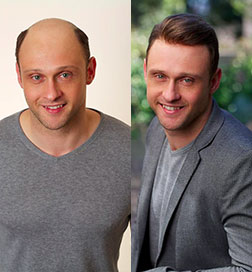Alopecia: Fast Facts
What does Alopecia mean?
Alopecia is a catchall phrase for hair loss. Any type of hair loss that you may have can loosely be defined as Alopecia.
The word Alopecia originates from ancient Greece where it was known as Foxes Disease because foxes would shed their fur twice a year. Much like Alopecia Areata, your hair can fall out and regrow, and fall out and regrow again, sometimes multiple times within a year, or even a lifetime.
Three Types of Alopecia
There are three common types or classifications of Alopecia:
1. Androgenetic Alopecia
As the name suggests, it is genetic in origin. Essentially there comes a time in your life where the body starts to shrink your hair follicles and you notice a thinning, especially through the top and also through the sides for women. The hair follicles shrink in size and become finer in texture, fluffy in nature, and generally very annoying. You also notice you can see through the scalp much more. It can be inherited from your parents, grandparents or wider community of people to whom you are related. These days, we’re also finding hair loss in women can be triggered by the contraceptive pill due to the hormonal nature of this form of hair loss. By and large, if you’re experiencing hair loss, it’s probably this one. It affects 80% of all people who experience hair loss.
2. Alopecia Areata
This is an autoimmune related form of hair loss. Usually you first notice it because you get these little 10 or 20 cent pieces of hair loss forming over the scalp, arms or your legs. Basically, the immune system is attacking the hair follicles and causing them to stop working, at least for a season. For most people, the hair does grow back, however, this is not the case for everyone. Within the category of Alopecia Areata there are three different degrees of Alopecia – Alopecia Areata, Alopecia Totalis, Alopecia Universalis.
Alopecia Areata – usually refers to the the 'spots' or 'patches' of hair loss.
Alopecia Totalis – refers to when a person has lost their hair all over their head but not their body.
Alopecia Universalis – refers to hair loss all over a persons head and body. It is 'universal' over their entire being.
For people with hair loss in the latter two stages we would recommend a Gripper wig. You can find more information about it here!
3. Diffuse Hair Loss or Telogen Effluvium (TE)
In most cases, this is a stress related form of hair loss or Alopecia. It can be triggered by having a physical shock to the body. It could be a surgical operation, a car accident, stopping or starting some form of medication. An extreme form of TE can be medically induced through chemotherapy. It could also be an emotional shock, like a relationship breakdown caused by a divorce, break up, death of a loved one, etc. Most people who go through Diffuse Hair Loss don’t lose all of their hair although you might notice a significant hair fall or shedding of yoru hair; lots of hair may come out all at once.
Generally speaking, if you look back three months into your history you may find what the cause is. Usually it takes three months after the event has occurred for the hair to start to fall out. Good news is, usually once the shock has passed your body has recovered, you’re in a better state – a much more whole and richer state as a person – your hair will tend to grow back. Just remember, your hair doesn’t grow back overnight, it does take time, but it will happen. It will start to come back in most circumstances – not for everyone but 90% of the time.
Do you have more questions? Get in touch: Ph: 1300 427 778 (Intl: +612 92124950). Or send us your details via our contact page.
Sydney Studio: 02 9212 4950
New Zealand: 0276530462




